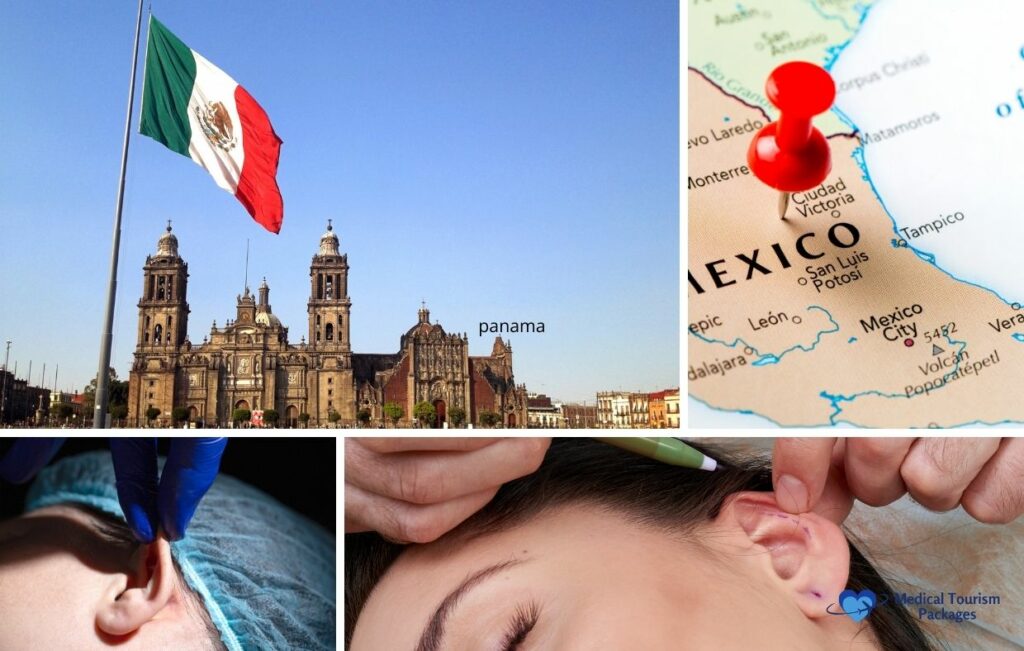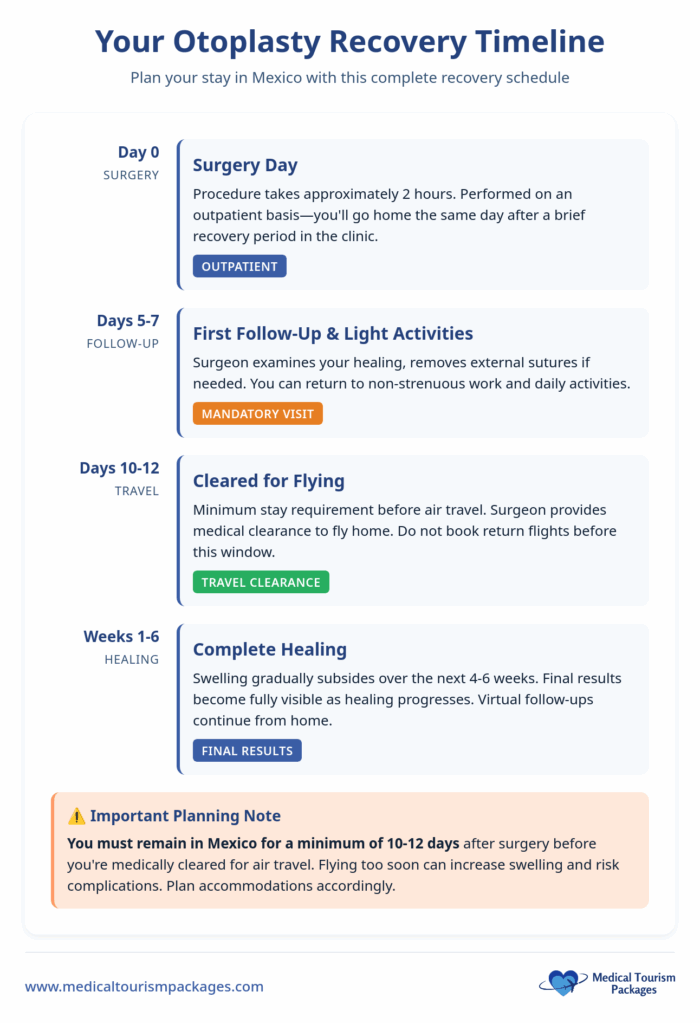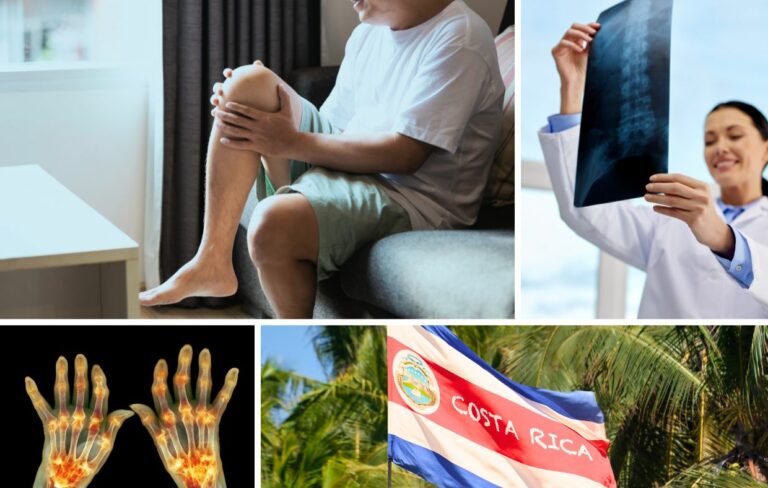Book Appointment Now

Otoplasty in Mexico: Complete Guide to Ear Surgery for Medical Tourists
Otoplasty is commonly known as ear surgery or ear pinning. It reshapes and repositions the ears for a more balanced facial appearance. This cosmetic procedure corrects protruding ears, oversized ears, or ear deformities. Many patients travel to Mexico for this surgery. They benefit from significant cost savings and access to experienced, board-certified surgeons.
Mexico has become a leading destination for medical tourists seeking otoplasty. Learn more about medical tourism in Mexico and why over 1.2 million Americans choose Mexico annually for medical procedures. The country offers savings of 60-71% compared to United States prices. Procedures range from $1,800 to $4,000 USD in Mexico versus $4,000 to $7,000 USD in the US. Beyond affordability, Mexico provides proximity to North America. This reduces travel time and costs. High-volume surgical centers maintain safety standards comparable to US facilities. Complication rates are around 2.2% per procedure.
This guide covers everything medical tourists need to know about otoplasty in Mexico, including costs, top surgical destinations, surgeon credentials, recovery expectations, and medical travel planning.
What is Otoplasty?
Otoplasty is a surgical procedure that reshapes the ears. It improves their appearance and position. The surgery addresses several common concerns. These include overly large ears (macrotia), ears that stick out too far from the head, and ear deformities caused by injury or congenital conditions.
Most otoplasty procedures take approximately two hours to complete. They are performed on an outpatient basis. This means patients go home the same day. The procedure uses local anesthesia combined with sedation. This keeps patients comfortable throughout the surgery.
During traditional otoplasty, the surgeon makes small incisions. These are strategically placed on the back surface of the ear or within the natural folds. This placement ensures scars remain hidden from view. Through these incisions, the surgeon accesses the ear’s cartilage structure. They carefully reshape it to create a more natural appearance. For ears that protrude significantly, surgeons may remove excess cartilage. This technique is called conchal reduction. Internal sutures then secure the ear cartilage in its new position. This holds the ears closer to the head. If you’re interested in comprehensive otoplasty services with all-inclusive medical tourism packages, learn more about our ear lift surgery options.
How Much Does Otoplasty Cost in Mexico?
Otoplasty in Mexico costs between $1,800 and $4,000 USD. The final price depends on several factors. These include whether you need surgery on one ear (unilateral) or both ears (bilateral). The surgeon’s level of experience and reputation affects cost. The city where you have the procedure matters. The specific clinic or hospital facility you choose also impacts the price.
| Country | Average Price Range (USD) | Potential Savings |
|---|---|---|
| Mexico | $1,800 – $4,000 | Baseline |
| United States | $4,000 – $7,000 (avg. $5,500) | 60-71% savings |
A patient paying $2,000 for otoplasty in Mexico would spend $5,500 on average for the same procedure in the United States. This represents a savings of $3,500. Even at the higher end of Mexico’s price range, patients still save significantly compared to US costs.
Why Choose Mexico for Otoplasty?
Mexico has established itself as a premier destination for medical tourism. The country welcomes between 1.2 and 3 million medical travelers each year. For plastic surgery specifically, 89% of international patients come from the United States and Canada. This reflects Mexico’s reputation for quality care and affordability.
Geographic proximity is a major advantage for North American patients. Most major Mexican medical tourism cities are just a short flight or drive from the US border. This reduces travel time and minimizes jet lag compared to destinations in Asia or Europe. Mexico’s high-volume surgical centers deliver clinical outcomes that match US standards. The overall complication rate is approximately 2.2% per procedure. For otoplasty specifically, success rates range from 90% to 97%. Over 98% of patients achieve stable, lasting results without needing revision surgery.
Surgeon quality in Mexico is exceptionally high. Many Mexican plastic surgeons hold dual certification from CMCPER (Consejo Mexicano de Cirugía Plástica Estética y Reconstructiva), the Mexican Board of Plastic Surgery. They also have international memberships in prestigious organizations. These include the American Society of Plastic Surgeons (ASPS) and the International Society of Aesthetic Plastic Surgery (ISAPS). Facilities that cater to international patients employ bilingual staff. They are fluent in English and Spanish. This ensures clear communication throughout your medical journey.
Best Cities in Mexico for Otoplasty
Choosing the right city for your otoplasty procedure depends on your priorities. Consider convenience, specialized expertise, recovery environment, and budget. Each of Mexico’s major medical tourism destinations offers distinct advantages for international patients seeking ear surgery.
| City | Best For | Key Advantage | Typical Price Range |
|---|---|---|---|
| Tijuana | US patients seeking maximum savings and convenience | Walking distance from Southern California border; minimal travel friction | $1,800 – $3,000 |
| Mexico City | Patients wanting cutting-edge techniques and specialized expertise | Hub for innovative incisionless otoplasty; experienced surgeons with 19+ years practice | $2,000 – $2,500 |
| Guadalajara | Those prioritizing optimal recovery climate | Winter climate with mild temps and low humidity ideal for healing | $1,900 – $2,800 |
| Cancun | Patients combining surgery with relaxing beach recovery | “Recovery in Paradise” model; discreet resort-style recuperation | $2,200 – $3,500 |

Tijuana remains the highest-volume destination due to its proximity to Southern California, making it ideal for patients prioritizing easy access and short travel times. Mexico City attracts those seeking specialized surgical institutes and the latest techniques. Guadalajara offers favorable climate conditions during winter months that naturally reduce post-operative swelling. Cancun provides a unique combination of medical care with a tranquil beach recovery environment.
How to Choose a Qualified Otoplasty Surgeon in Mexico
Selecting the right surgeon is the most important decision in your medical tourism journey. Use this triple verification model to ensure your surgeon meets the highest standards of training, certification, and experience.
What is CMCPER Certification and Why Does It Matter?
CMCPER (Consejo Mexicano de Cirugía Plástica Estética y Reconstructiva) is also known as AMCPER. It is Mexico’s official board certification for plastic surgeons. This certification ensures your surgeon completed rigorous medical training. This includes medical school, general surgery residency, and specialized plastic surgery residency. Always verify your surgeon holds current CMCPER certification. Ask to see proof before scheduling your procedure. This certification confirms your surgeon meets Mexico’s highest national standards for plastic surgery practice.
Why Should I Verify International Memberships?
International memberships in organizations like ASPS (American Society of Plastic Surgeons) or ISAPS (International Society of Aesthetic Plastic Surgery) are important. They demonstrate that your surgeon meets global standards, not just local requirements. These prestigious memberships have strict requirements. Surgeons must maintain continuing education. They must adhere to strict ethical guidelines. They must demonstrate proven expertise in plastic surgery. Many top Mexican surgeons maintain dual credentials. They hold both CMCPER certification and ASPS or ISAPS membership. This gives you confidence in their qualifications.
How Can I Check a Surgeon’s Otoplasty Experience?
Verify your surgeon’s specific experience performing otoplasty procedures through multiple channels. Review detailed patient testimonials and before-and-after photos specific to otoplasty. Use independent platforms like RealSelf or the clinic’s verified gallery. Check the surgeon’s profile on the ASPS website if they’re a member. This shows their credentials and specializations. Ask the clinic directly about how many otoplasty procedures the surgeon performs annually. A surgeon who completes dozens of ear surgeries each year will have more refined technique. They will have better outcomes than one who performs the procedure occasionally.
What Accreditations Should Clinics Have?
The facility where you have your otoplasty is just as important as the surgeon who performs it. Proper accreditations ensure the clinic meets strict safety standards. They confirm the clinic maintains sterile environments and follows established protocols for patient care. Look for these key certifications when evaluating Mexican surgical facilities:
- Joint Commission International (JCI) accreditation is the highest global standard for patient safety and quality of care, placing facilities on par with top US hospitals.
- Mexican Council of the Medical Tourism Industry (COEMCO) membership indicates the clinic understands the unique needs of medical tourists and follows best practices for serving foreign patients.
- AMCPER facility standards compliance ensures the clinic has been evaluated for proper surgical equipment, sterile operating rooms, and appropriate emergency protocols specific to plastic surgery facilities.
- Modern equipment and high-quality surgical materials comparable to accredited US surgical centers, including FDA-approved or internationally recognized surgical materials.
Reputable facilities will proudly display their certifications on their websites and provide verification upon request.
Otoplasty Safety and Success Rates in Mexico
Data from high-volume, accredited Mexican surgical centers demonstrates that otoplasty in Mexico is both safe and effective when procedures are performed by board-certified surgeons in properly accredited facilities.
| Metric | Rate in Mexican Centers | What This Means |
|---|---|---|
| Overall Complication Rate | 2.2% per procedure | Comparable to US standards |
| Success Rate | 90-97% | High confidence in results |
| Revision Rate | \<2% | Exceptional quality |
| Lasting Results | >98% | Permanent correction achieved |
The 2.2% complication rate is comparable to benchmarks published by board-certified plastic surgeons in the United States. The success rate of 90-97% indicates that the vast majority of patients achieve their desired aesthetic outcome, with ears properly positioned, symmetrical, and naturally proportioned to the face.
While otoplasty is generally safe, all surgical procedures carry some risk. The most common potential complications, though rare, include infection (treatable with antibiotics), hematoma (blood collection that may require drainage), minor asymmetry (slight differences between ears), and visible scarring (more common in patients with genetic predisposition to thick scarring). These complications occur infrequently, particularly when you choose an experienced, board-certified surgeon and follow all post-operative instructions carefully.
Otoplasty Techniques Used in Mexico
Mexican plastic surgeons use both traditional and advanced minimally invasive techniques to perform otoplasty. The choice depends on your specific ear anatomy, the type of correction needed, and your surgeon’s assessment during consultation.
| Technique | How It Works | Best For | Recovery |
|---|---|---|---|
| Traditional Otoplasty | Small incisions hidden on back of ear; cartilage directly accessed, reshaped, or removed; internal sutures hold ear in new position | All types of ear corrections; ears requiring significant cartilage removal | Standard recovery; incisions heal invisibly; well-established technique |
| Incisionless Otoplasty | Retention sutures inserted through tiny punctures; cartilage reshaped from within without exposing structure | Prominent ears from absent antihelical fold or conchal hypertrophy; no excess cartilage removal needed | Quicker recovery; ideal for medical tourists; minimal visible signs of surgery |
What is Traditional Otoplasty and How Does It Work?
Traditional otoplasty is the most established technique. It can address virtually any ear concern, including cases requiring removal of excess cartilage. The surgeon makes incisions strategically placed on the back surface of the ear or within natural folds. This placement ensures they remain invisible after healing. Through these incisions, the surgeon directly accesses the ear’s cartilage structure. They carefully reshape it. For protruding ears, excess cartilage may be removed through conchal reduction. Internal sutures then secure the ear in its new position. This holds the ears closer to the head for a more balanced appearance.
What is Incisionless Otoplasty and Who is It For?
Incisionless otoplasty is a minimally invasive approach. It has gained popularity in Mexico’s top surgical centers, particularly in Mexico City. Instead of traditional incisions, the surgeon inserts retention sutures through tiny punctures in the skin. These sutures reshape and reposition the ear cartilage from within. This achieves correction without exposing the cartilage structure. This technique is best for patients with prominent ears. It works for those with absent antihelical fold or conchal hypertrophy who don’t require cartilage removal. It offers substantial benefits. These include easier recovery, faster return to normal activities, and minimal visible signs of surgery. This makes it ideal for medical tourists who want to minimize recovery time in Mexico.
The Otoplasty Consultation Process
The consultation process for otoplasty in Mexico is designed for convenience, especially for international patients. Most Mexican surgeons offer virtual consultations that allow you to evaluate the surgeon and discuss your goals before committing to travel.
The process begins when you contact the clinic and submit your basic contact information and high-quality photographs of your ears. The surgeon uses these photos to assess your ear anatomy, determine candidacy, and begin planning the surgical approach. Once the surgeon confirms you’re a suitable candidate, the clinic schedules a formal virtual consultation via video platforms such as Zoom, WhatsApp Video, Skype, or FaceTime.
During this video call, you’ll discuss your aesthetic goals and what you hope to achieve with otoplasty. The surgeon will explain which technique is most appropriate for your case, set realistic expectations for outcomes, and outline the surgical plan in detail.
Prepare these items for your consultation:
- Contact information with country code and preferred communication method
- Clear, high-quality photographs from multiple angles (front, sides, back with hair pulled back, close-ups)
- Complete medical history including previous surgeries, chronic conditions, allergies, current medications, and any history of keloid scarring
- Written list of questions about credentials, procedure details, recovery, and follow-up care
Most clinics provide a detailed quote after the consultation that includes all costs, recommended length of stay in Mexico, and specific pre-operative instructions.
Otoplasty Recovery Timeline
Understanding the recovery timeline helps you plan your stay in Mexico. It helps you prepare for what to expect after surgery. The procedure itself takes approximately two hours. It is performed on an outpatient basis. You’ll go home the same day after a brief recovery period in the clinic.
| Milestone | Timeframe | Details |
|---|---|---|
| Procedure Duration | 2 hours | Outpatient; go home same day |
| Return to Light Activities | 5-7 days | Non-strenuous work and daily activities |
| First Follow-Up | 5-7 days | Surgeon checks healing, removes sutures if needed |
| Cleared for Flying | 10-12 days | Minimum stay in Mexico before air travel |
| Swelling Subsides | Up to 6 weeks | Complete healing and final results |
Most patients can return to light activities within 5-7 days. This includes non-strenuous work and normal daily routines. Your surgeon will schedule a critical follow-up appointment 5-7 days after surgery. They will examine your incisions and remove any external sutures. This appointment must occur before you’re cleared to fly home.
The most important consideration for medical tourists is the flying clearance. You must remain in Mexico for a minimum of 10-12 days after surgery. This is required before you’re medically cleared for air travel. Flying too soon can increase swelling and risk complications.

What Post-Operative Care is Essential in the First Week?
Proper post-operative care during your first week in Mexico is crucial for optimal healing and preventing complications. Follow these essential guidelines:
- Keep wounds clean and protected from direct sunlight; wear a hat or use sunscreen once cleared
- Stay hydrated with plenty of water, as Mexico’s warm weather increases perspiration
- Avoid strenuous activities, contact sports, or heavy lifting that could increase blood pressure
- Sleep with head elevated using extra pillows; sleep on your back to avoid pressure on ears
- Follow surgeon’s specific wound care instructions for cleaning and dressing changes
- Attend scheduled follow-up appointment before flying home (mandatory)
Planning Your Stay in Mexico
Proper planning ensures a smooth medical tourism experience and optimal recovery. Plan for a minimum 10-12 day stay in Mexico after your surgery. This is the required time for post-operative monitoring. You need this before you’re medically cleared to fly home.
Choose your accommodation carefully. It directly impacts your recovery comfort. Your lodging should be quiet to promote rest. It should be clean with good hygiene standards to minimize infection risk. It should be well-ventilated with fresh air circulation. Many clinics can recommend nearby hotels or recovery houses. These cater specifically to medical tourists.
Timing your surgery for the right season can significantly improve your recovery experience. Consider scheduling your otoplasty during Mexican winter months (November through February). This is particularly true in inland cities like Guadalajara, Mexico City, or Monterrey. This season offers optimal recovery conditions. It has mild daytime temperatures and significantly lower humidity levels. Cooler evenings help you sleep better. This cooler, less humid environment helps minimize post-operative swelling. It allows your body to focus energy on healing rather than temperature regulation.
What Results Can You Expect?
Otoplasty provides permanent correction of ear position and shape. Once the cartilage heals in its new position, the results last for life. You won’t need repeat procedures to maintain your results as you age. Success rates for otoplasty are excellent. 90-97% of patients achieve stable, natural-looking results. These meet or exceed their aesthetic goals.
Scarring is minimal and well-concealed. Surgeons place incisions strategically on the back surface of the ear or within natural folds. As the scars mature over several months, they fade to thin, pale lines. These blend with the natural contours of the ear. Most people will never know you’ve had ear surgery unless you tell them.
Patient satisfaction rates are notably high with otoplasty. Most patients report that the procedure significantly improves their confidence and self-image. Psychological benefits often exceed the physical changes. The improvement is immediately noticeable once bandages are removed. Your final results become fully apparent after swelling subsides over 4-6 weeks.
Arranging Follow-Up Care
Follow-up care is essential for monitoring your recovery and ensuring optimal results. Mexican surgeons provide structured follow-up both during your stay and after you return home.
Your surgeon will schedule a mandatory in-person follow-up appointment 5-7 days after surgery. During this visit, the surgeon examines your incisions to confirm proper healing. They remove external sutures if needed. They assess the position and shape of your ears. This appointment is the gateway to receiving medical clearance for air travel. Do not book return flights before this appointment. Do not attempt to leave Mexico without explicit clearance.
Once you return home, follow-up care continues through virtual consultations. These use video platforms like WhatsApp, Zoom, or FaceTime. These virtual check-ins usually occur at 2 weeks, 4 weeks, and 3 months post-surgery. During these appointments, you’ll show your surgeon your healing progress. Use your device’s camera or send high-quality photos.
Some medical tourists prefer having local follow-up options in their home country. This provides additional peace of mind. You can pre-arrange follow-up care with board-certified plastic surgeons in your home area. They offer post-operative monitoring services specifically for medical tourism patients.
Frequently Asked Questions About Otoplasty in Mexico
Is otoplasty in Mexico safe for children?
Yes—when performed by board-certified surgeons in accredited facilities. Most surgeons recommend waiting until ages 5–6, when ear cartilage is sufficiently developed. Many families from the U.S. and Canada travel to Mexico for pediatric otoplasty, gaining cost savings without compromising safety or quality.
Can I combine otoplasty with other procedures in Mexico?
Yes. Otoplasty can be combined with other facial procedures (e.g., rhinoplasty or rejuvenation). This may extend your stay and recovery. Discuss goals during your virtual consultation so your surgeon can design a safe, comprehensive plan.
When is the best time of year to schedule otoplasty in Mexico?
Winter months (November–February) are ideal, especially in inland cities like Guadalajara, Mexico City, and Monterrey. Milder temperatures and lower humidity can help reduce swelling and make recovery more comfortable.
What happens if I fly home before the 10–12 day minimum stay?
Flying too soon can increase swelling and risks like bleeding or hematoma, and may compromise results. Cabin pressure changes affect healing tissues, and you may miss crucial follow-up. Always wait for explicit medical clearance before booking your return flight.
Is financing available for otoplasty in Mexico?
Many clinics offer financing or payment plans, often through partners that specialize in medical tourism. Contact clinics directly to discuss options, accepted payment methods, and installment plans that meet your budget.
Do I need to speak Spanish to have otoplasty in Mexico?
No. Clinics serving medical tourists have bilingual teams. Surgeons, coordinators, and nursing staff commonly speak English, and many facilities provide English-language consent forms and post-operative instructions.
How many otoplasty procedures should my surgeon have performed?
Look for surgeons performing at least 50–100 otoplasties annually to maintain refined technique. Ask about their annual volume, request before-and-after photos of similar cases, and confirm specialization in facial plastic surgery or ear reconstruction.
Will my insurance cover otoplasty in Mexico?
Most U.S. insurance plans don’t cover cosmetic otoplasty. If medically necessary (e.g., injury, congenital deformity, or functional issues), some plans may allow partial reimbursement. Verify benefits with your insurer before traveling. Even without coverage, Mexico often offers 60–71% savings compared to U.S. prices.
Why is otoplasty cheaper in Mexico than in the U.S.?
Lower overhead—facility costs, staffing, and malpractice insurance—plus a favorable exchange rate and cost of living reduce prices. High-quality surgeons and JCI-accredited facilities use the same techniques, equipment, and materials as in the U.S.
Is otoplasty permanent, or will I need touch-ups?
Results are permanent once the cartilage heals in its new position. The vast majority of patients—over 98%—maintain stable results without revision. A small percentage may need minor touch-ups due to healing variability or asymmetry.
Is Otoplasty in Mexico Right for You?
Mexico offers exceptional value for otoplasty with 60-71% cost savings compared to US pricing. With board-certified surgeons, JCI-accredited facilities, and success rates of 90-97%, you receive world-class care at affordable prices. Clinical outcomes match US standards with complication rates of just 2.2% per procedure.
Ready to transform your appearance and boost your confidence? Our experienced medical tourism coordinators will connect you with top-rated, CMCPER-certified otoplasty surgeons in Mexico. Contact us today for a free consultation and personalized treatment plan tailored to your goals and budget.



